Played on PC
Despite the fact that the third numbered part of Orcs Must Die! was received quite warmly by the community, the lack of fresh ideas and fatigue from the stagnation of mechanics and game principles of the series were clearly felt. Robot Entertainment rightly judged that Orcs Must Die! could do with some rethinking (even if not as extreme as the miserably failed Unchained), which would noticeably change many of the basic principles of the game cycle. For example, roguelike elements, expanded cooperative capabilities and as many as six new characters with unique game styles. And instead of successive levels with gradually increasing difficulty and a developing story, players themselves choose the next location for the battle. On the one hand, this is an interesting idea that allows you to build your own mini-adventure in each sortie, on the other hand, the narrative was almost entirely cut. After all, in the numbered parts, the plot, although exclusively functional, still collected different game segments into one more or less coherent story. In Deathtrap, the narrative is essentially abolished.
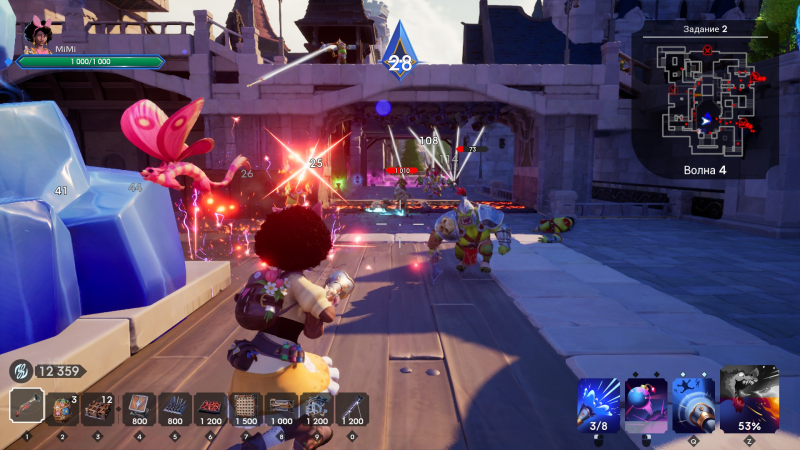
A run in Orcs Must Die! Deathtrap consists of battles against six waves in one location, then six in another, and so on until the final fight with the boss
⇡#Battle mages, assemble!
The countless hordes of orcs, trolls, gnolls and other evil creatures are rushing towards the portals again, but this time the enemies have split into four different factions. Each gang is led by a powerful general, and each one is eager to become the supreme ruler of the orcs, who will subjugate the entire fantasy world to his iron will. Naturally, our goal is to prevent such an outcome and send all the generals into permanent retirement.
To get to the bad guys, we have to do… the same thing as always – protect the portals from waves of enemies. Here, Orcs Must Die! Deathtrap does not change traditions. At the planning stage, you study the entire location and the paths that the orc hordes will take; you notice successful and most advantageous points for placing traps; you set up barricades (now they are free, but their number is limited) and, of course, decorate the local interiors and exteriors with floor, wall and ceiling traps. And, finally, it’s time for the battle: crowds of enemies invade the location, who will test our strategic plan with their carcasses, and those who are lucky enough to slip through the gallery of deadly “surprises” will have to evaluate the power of the player’s combat magic.
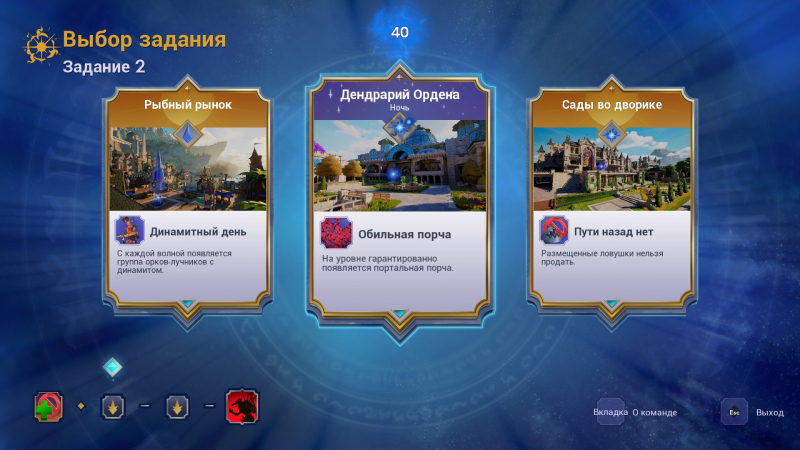
Each location offers one random condition that significantly (or not so much) complicates the game
The first noticeable change you will notice immediately after the first orc wave dries up – after the battle you are offered one of three rewards to choose from. There are a variety of buffs: there is an increase in the power of a certain trap, and an increase in the combat characteristics of an entire type of device; and a decrease in the cost of certain orc-killing tools; and an increased chance of getting one of the local currencies. There are also options that give a particularly noticeable increase in power, but the price for the acquired power will be appropriate. For example, you can double the number of available barricades, but all other traps will become ten times (!) more expensive; or you immediately receive ten portal points (that is, additional portal health), but if the battle mage under your control is killed, the portal will receive additional damage.
To prevent our protégés from dying too often, it is worth paying attention to the buffs for heroes: immunity to certain statuses; an increase in maximum health; or an increase in combat power – slain orcs will no longer cause damage. The last category also includes buffs intended exclusively for certain heroes.
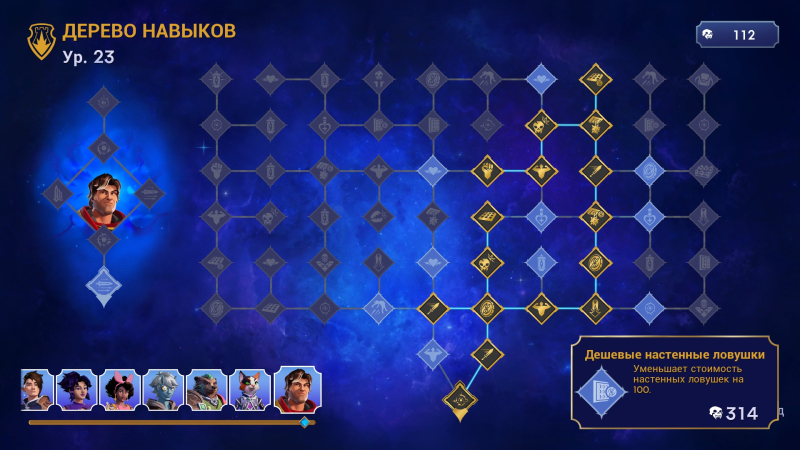
You can use the skulls you collect to purchase new traps and boosts for your runs, or fork out for general upgrades and personal hero power.
Six (seven, if you count Maximilian, who will join the company if you fulfill a certain condition) characters offer radically different methods and principles of fighting orcs. For example, the sorceress Wren relies on magical long-range attacks, powerful area-of-effect spells, and one of my favorite mechanics – active reloading, the success of which will give a number of pleasant bonuses to the next “magazine” of the magic wand. Mac is a kind of sniper, capable of inflicting monstrous damage from afar and rarely, but accurately hitting orcs thanks to a sight with magnification. Vaan, on the contrary, fires a crossbow from the hip with stunning speed, so much so that half of the “magazine” flies into the milk from the recoil. And the cheerful Harlow relies on a blunderbuss – it is not very good against long-range targets, but sweeps away everything alive at close range.
And, of course, Orcs Must Die! Deathtrap also has a couple of characters for extremely close encounters with orcs. The anthropomorphic cat Sophie solves problems with daggers, fast combos and critical damage, and the heavy bear Kalos deals with enemies with a less elegant club. He also acts as a kind of tank and support hero in one person – Kalos can “digest” much more damage than his colleagues, and will help restore the health of his teammates with his super attack.
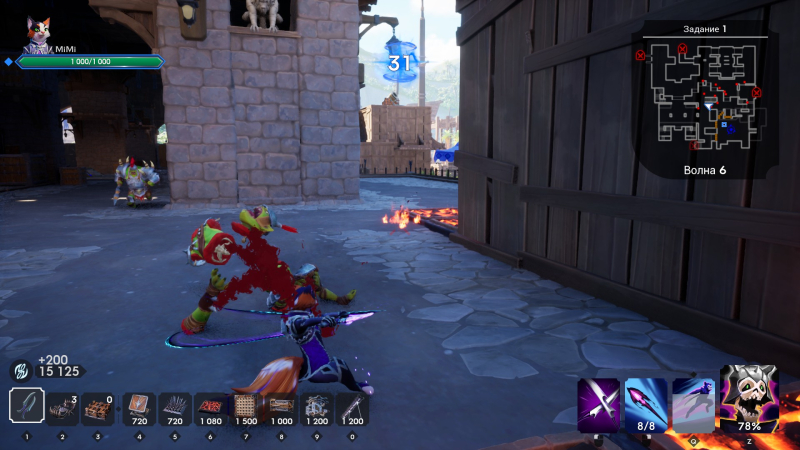
Melee heroes can’t attack and move at the same time, which is frankly a very strange decision.
To use super attacks, you need to accumulate charge during the combo (the counter spins when you destroy enemies in different ways). And for each hero, this is a truly extremely powerful ability that can change the course of the race. Vaan, for example, can protect the portal with a time barrier and prevent the loss of points – sometimes this is the difference between victory and defeat. Wren calls on her mirror copies, which exactly repeat her attacks, which increases the damage many times. And, say, Sophie calls Bartholomew – a huge skeleton soldier – for help. It is worth using this trump card wisely, because the super attack charge accumulates for some time, and inappropriate use of the ultimate ability can easily lead to the collapse of the race, when in a really hot moment there will be nothing to answer the crowd of enemies with. And such moments happen quite often, especially if you play solo.
⇡#There is no place for single people here
Overall, the roguelike elements were well received – it’s really interesting to strengthen your “build” not only outside of missions, but also during raids. And the heroes with their personal sets of skills and features are good – even Sophie and Kalos with their strange and extremely inconvenient system of motionless melee combat are interesting to play. And four-person runs are a fun experience, especially if the players know and understand their roles. But the overall balancing of the gameplay and the focus on four-player co-op significantly spoil the overall impression if you decide to play on your own or with an incomplete party. Because four-player hack-and-slash is not an option, but a gameplay necessity.
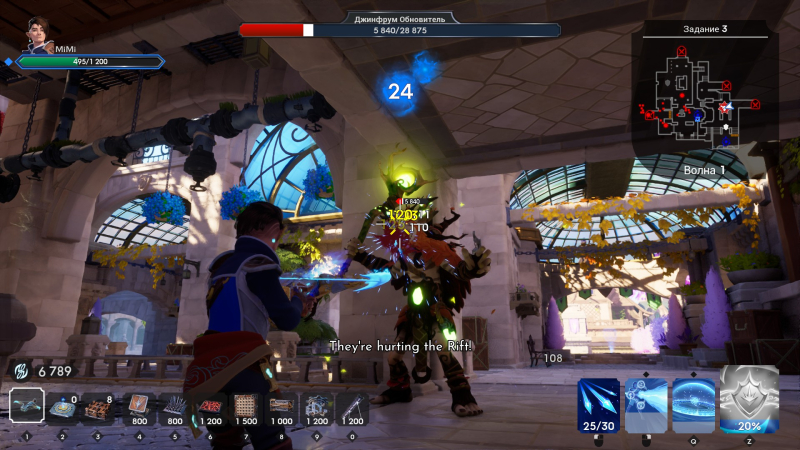
Boss fights are quite chaotic, and you can defeat the “mighty” archenemy in literally ten seconds
Of course, you can try to overcome Orcs Must Die! Deathtrap in proud solitude, but in this case, by the middle of the run, each wave will be given with incredible creaking, and even the slightest mistake in planning or execution will lead to inevitable defeat. And if the excessive number of directions in which the enemy waves move is not such a big problem – thanks to free barricades (which, however, are barely enough to build a dense defense, and this is quite noticeable), then the number of enemies and their exponentially growing survivability is already a headache.
Of course, if you level up enough, focus on playing one specific hero (by the way, Max is completely unbalanced and feels many times stronger than newbies), collect the perfect set of traps, and know every map and its features inside and out, then your chances of reaching the boss will be an order of magnitude higher. But no one has canceled the element of randomness in “roguelikes”, and literally a couple of not the most useful prizes can easily bury a polished strategy.
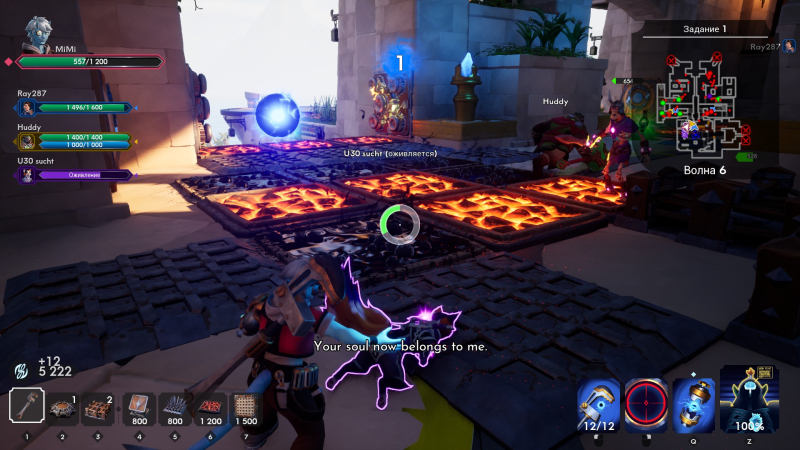
Another advantage of playing in four players: when someone takes critical damage, their teammates can pump it out
And to collect enough resources for serious pumping, you will have to go through the same levels several times – this is tiring both alone and in a company. In the numbered parts, even the most unpleasant levels could be endured and then ignored. In Deathtrap, the total number of locations and the principle of their rotation will send you over and over again to places that you can no longer see. And even pleasant maps on the fifth time already begin to get boring. Like Orcs Must Die! Deathtrap itself.
***
The new Orcs Must Die! has slightly refreshed the usual process of exterminating orcs, but everything is ruined by unsuccessful difficulty balancing and dull monotony. It seems that the game would not hurt additional testing and polishing. However, we must give credit to Robot Entertainment here – the developers listen to the community and actively correct the shortcomings that players point out en masse. Perhaps in a month or two this will be a much higher quality and more detailed game, but it still will not jump above its head.
Advantages:
- Six new heroes, all with unique abilities and their own approach to exterminating the orc hordes;
- The basic formula of Orcs Must Die! is still fun, especially when playing with four players;
- Roguelike elements bring a fresh twist to the series’ classic formula.
Disadvantages:
- At a certain point the game devolves into a boring grind;
- Melee heroes cannot attack and walk at the same time;
- The balance is obviously designed for four players – playing alone is both boring and difficult.
Graphic arts
Only the most dedicated fans will notice the difference between the first Orcs Must Die! and Deathtrap with the naked eye: the basic design of locations, the appearance and animations of orcs, trolls, gnolls and elementals have not undergone any noticeable changes over the years, except that the level of detail and quality of effects have noticeably increased.
Sound
The sound design is standard for the series – functional, but without much depth or richness. And some sound effects (like the sound of Wren’s magic wand recharging) are literally grating on the ear, forcing you to play without sound. The inexpressive battle themes and arrangements of melodies from previous games are unlikely to cause a storm of emotions even among fans of the series.
Single player game
A roguelike in the aesthetics of Orcs Must Die!, it gives almost the same emotions as the older games in the series, but the excessive monotony of the gameplay and inadequate difficulty curve noticeably darken the gaming experience.
Estimated time of completion
It will take about twenty hours to complete the game to its conditional ending.
Collective game
Orcs Must Die! Deathtrap is designed for cooperative play, so it is best to fight the countless hordes of orcs in a company. However, already in the first weeks there were hardly more than ten parties in the lobby.
General impression
Orcs Must Die!’s basic formula and roguelike elements work well together, and the six new heroes are great, but serious balance issues and significant design flaws prevent the game from fully revealing itself.
Rating: 6.0 / 10
More about grading system
Video: